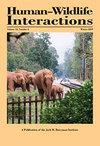经过美国东部几十年的郊区鹿研究和管理:我们从这里走向何方?
IF 0.9
4区 环境科学与生态学
Q4 BIODIVERSITY CONSERVATION
引用次数: 5
摘要
在美国,州野生动物机构对鹿(鹿科)的管理有管理权力和监督。然而,城市扩张的加剧和鹿群的过剩造成了越来越多的人鹿冲突。由于围绕传统管理方法的使用(如在美国东部郊区有规定的狩猎)的争议越来越大,管理人员现在正在使用专门的工具和管理方法来减少城市地区的鹿冲突。然而,当他们试图满足不同利益相关者群体的愿望时,这带来了新的挑战。尽管每个州的城市地区的鹿管理计划有所不同,但有效的管理选择仍然有限。从本质上讲,使用了30年的管理工具并没有改变,即使对鹿的研究进行了大量投资。尽管公众支持鹿的生育控制,但它在很大程度上仍然是实验性的,而且价格昂贵。由于自由放养的鹿撤退的成本和困难,很少使用免疫避孕疫苗。鹿的手术绝育已经显示出希望,但应用的规模仍然受到成本和需要处理的鹿的数量的限制。在一个可接受的时间框架内,在多个尺度上,杀死鹿仍然是唯一能够持续减少鹿数量的方法。即使在使用致命方法大幅减少城市鹿数量的地区,对鹿数量和人鹿冲突的影响也很少有记录。在高度分散的发达景观中,清除足够的鹿以证明减少影响是一个困难而昂贵的过程。通常需要好几年的多种方法才能达到预期的结果。因此,缺乏长期计划和维持管理工作所需的足够预算可能会阻碍总体规划的成功和可持续性。在此,我回顾了从美国东部郊区的鹿研究和管理工作中获得的经验教训,并强调了未来城市鹿管理计划的潜在方向。本文章由计算机程序翻译,如有差异,请以英文原文为准。
After Decades of Suburban Deer Research and Management in the Eastern United States: Where Do We Go From Here?
State wildlife agencies have regulatory authority and oversight over deer (Cervidae) management in the United States. However, increased urban sprawl and overabundant deer populations have created increased human–deer conflicts. Because of the growing controversy surrounding the use of traditional management practices such as regulated hunting in suburban areas in the eastern United States, managers are now using specialized tools and management approaches to reduce deer conflicts in urban areas. However, this has created new challenges as they try to meet the desires of diverse stakeholder groups. Although deer management programs in urban areas differ somewhat in every state, effective management options remain limited. Essentially the same management tools that were used for 3 decades have not changed, even with substantial investments in deer research. Despite public support for deer fertility control, it is still largely experimental and expensive. Immunocontraceptive vaccines are seldom used because of the cost and difficulty of retreating free-ranging deer. Surgical sterilization of deer has shown promise, but the scale of application remains limited by cost and the number of deer that need to be handled. Lethal deer removal remains the only method that has consistently reduced deer numbers in an acceptable time frame at multiple scales. Even in areas where urban deer numbers have been substantially reduced using lethal methods, the resulting effects on deer populations and human–deer conflicts have been poorly documented. In highly fragmented, developed landscapes, removing enough deer to demonstrate impact reduction has been a difficult and expensive process. It usually takes multiple approaches across several years to achieve desired results. Thus, the lack of longterm planning and sufficient budgets needed to sustain management efforts may impede overall program success and sustainability. Herein, I review the lessons learned from multiple deer research and management efforts from suburban areas in the eastern United States and highlight potential directions for future urban deer management programs.
求助全文
通过发布文献求助,成功后即可免费获取论文全文。
去求助
来源期刊

Human–Wildlife Interactions
Environmental Science-Nature and Landscape Conservation
CiteScore
2.80
自引率
0.00%
发文量
0
审稿时长
11 weeks
期刊介绍:
Human–Wildlife Interactions (HWI) serves the professional needs of the wildlife biologist and manager in the arena of human–wildlife conflicts/interactions, wildlife damage management, and contemporary wildlife management. The intent of HWI is to publish original contributions on all aspects of contemporary wildlife management and human–wildlife interactions with an emphasis on scientific research and management case studies that identify and report innovative conservation strategies, technologies, tools, and partnerships that can enhance human–wildlife interactions by mitigating human–wildlife conflicts through direct and indirect management of wildlife and increased stakeholder engagement. Our intent is to promote a dialogue among wildlife professionals concerning contemporary management issues. As such, we hope to provide a repository for wildlife management science and case studies that document and share manager experiences and lessons learned.
 求助内容:
求助内容: 应助结果提醒方式:
应助结果提醒方式:


